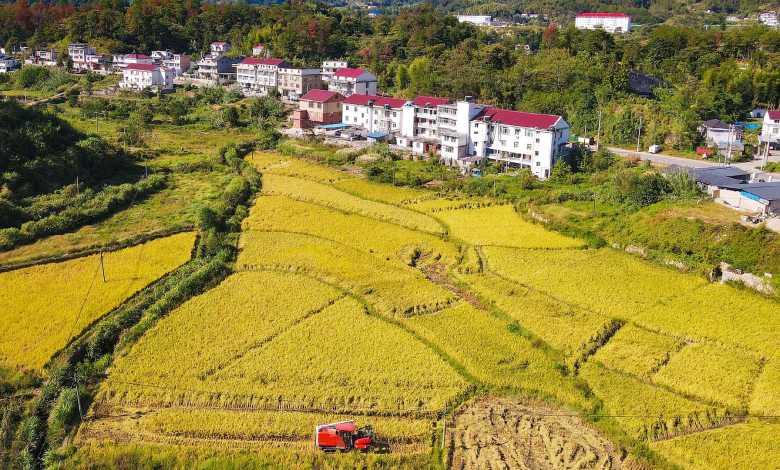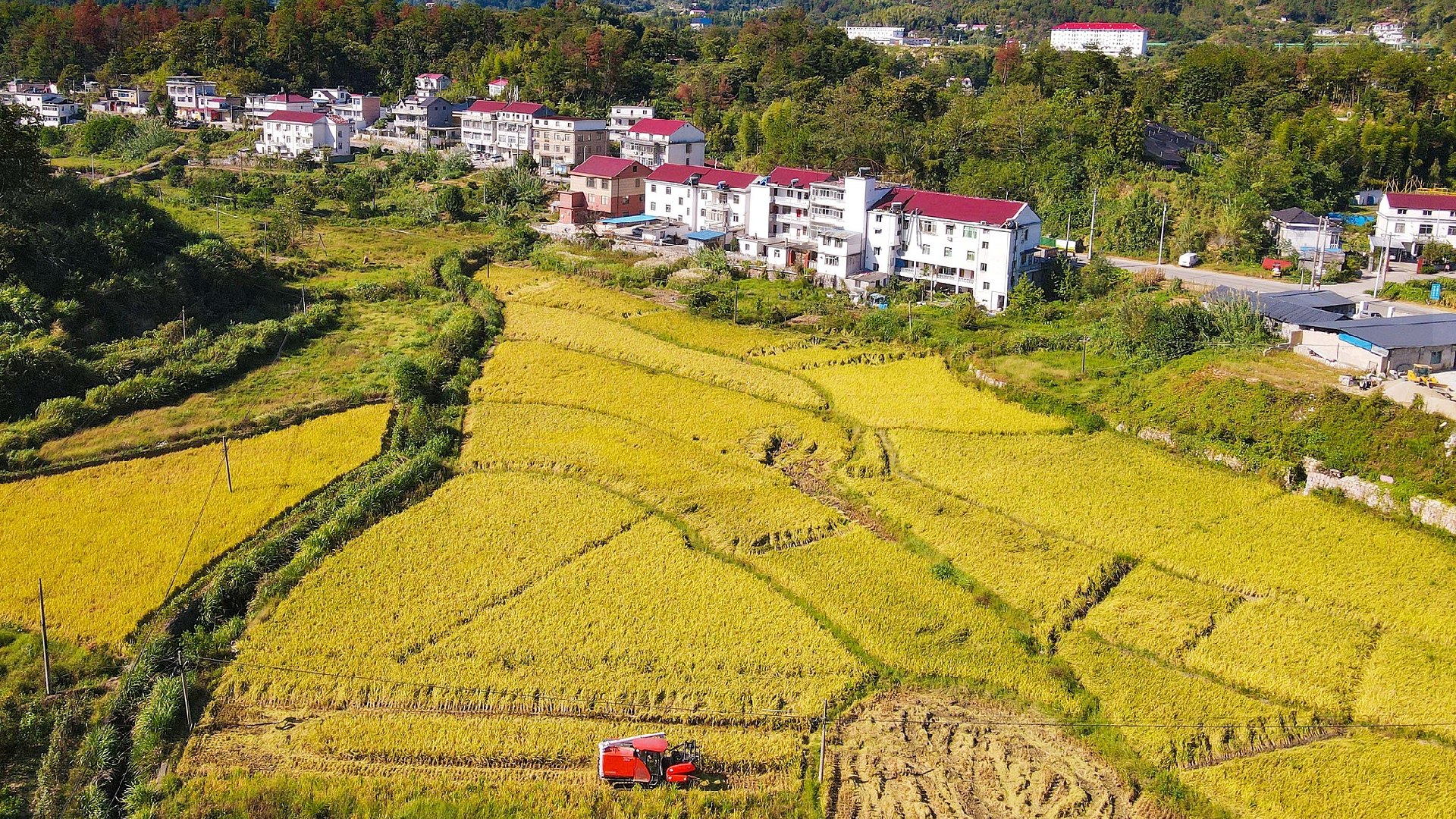Technology assists acceleration of China's agricultural modernization


<img src='https://news.cgtn.com/news/2024-09-22/Technology-assists-acceleration-of-China-s-agricultural-modernization-1x6dlruDT8I/img/69dca2b0d91648c393cb6ebf45e280e6/69dca2b0d91648c393cb6ebf45e280e6.png' alt='Farmers driving harvesters to collect mature rice crop in Anhui Province, China, September 22, 2024. /CFP'
Editor’s note: Li Chunding is a professor at the School of Economics and Management at China Agricultural University. Zhou Yanni is a doctoral student at the School of Economics and Management at China Agricultural University. The article reflects the authors’ opinions and not necessarily the views of CGTN.
The vast fields of China resonate with the hum of agricultural machinery, orchestrating a symphony of harvest. In 2023, China’s total grain output reached 695.41 billion kilograms, marking nine consecutive years of stability above 650 billion kilograms. In 2024, summer grains have once again yielded a bumper harvest. And with a steady increase in autumn grain acreage, another abundant season is anticipated. Behind these achievements lies the rapid advancement of agricultural modernization and the formidable force of technological innovation in China.
Technological innovation promotes agricultural modernization
Core to grain yield improvement is the enhancement of crop variety. In recent years, China has made significant breakthroughs in breeding major grain crops such as rice, wheat, and corn. Through gene editing and hybrid breeding technologies, high-yield, high-quality new varieties that are resistant to pests, diseases, drought, and water-logging have been developed. For instance, the promotion of “super rice” has significantly increased per-unit rice yields, contributing substantially to grain production growth.
The integration of the Internet of Things (IoT), big data, and artificial intelligence (AI) is profoundly transforming traditional agriculture. Field sensors provide real-time monitoring of soil moisture, temperature, and nutrient levels. Intelligent irrigation systems use this data to precisely control water application, conserving water resources while optimizing crop growth conditions. The use of drones for pesticide application has increased efficiency, reduced pesticide usage, and minimized environmental pollution.
Close collaboration between research institutions and farmers has accelerated the transformation of agricultural technological achievements. Agricultural technology extension stations have been established nationwide, offering regular training to enhance farmers’ technological literacy. Demonstration fields showcase the significant effects of new technologies and varieties, driving regional agricultural development.
<img src='https://news.cgtn.com/news/2024-09-22/Technology-assists-acceleration-of-China-s-agricultural-modernization-1x6dlruDT8I/img/6ed3ba4c03b840b1973d88775f49a05f/6ed3ba4c03b840b1973d88775f49a05f.jpeg' alt='Drones carrying out pest control and crop fertilization in the fields, Hebei Province, China, September 14, 2024. /CFP'
Agricultural mechanization enhances production efficiency
Substantial investment in modern agricultural machinery has markedly enhanced production efficiency. High-performance harvesters, seeders, transplanters, and plant protection drones have shifted agricultural production from manual labor to mechanization and automation. The application of automatic navigation and precise positioning technologies has made machinery operation more efficient and convenient.
The increased level of mechanization has laid the foundation for large-scale agricultural operations. Through land transfers and cooperative models, farmers have achieved centralized land management, increasing the utilization rate of mechanical equipment. Large-scale operations not only reduce production costs but also enhance market competitiveness, making agricultural production more efficient and sustainable.
<img src='https://news.cgtn.com/news/2024-09-22/Technology-assists-acceleration-of-China-s-agricultural-modernization-1x6dlruDT8I/img/3bed269b6ea94240a1a9bec2b3c0dbb3/3bed269b6ea94240a1a9bec2b3c0dbb3.png' alt='A worker assembling farming equipments in a factory in Xinjiang Uygur Autonomous Region, China, September 14, 2023. /CFP'
Policy support bolsters agricultural modernization
Robust government support is crucial for advancing agricultural modernization. Subsidies for agricultural machinery purchases have alleviated the financial burden on farmers acquiring advanced equipment, rapidly elevating mechanization levels. For new agricultural business entities like family farms and cooperatives, the government provides financial and technology support, promoting the organization and scaling up of agricultural production.
The government has increased investment in agricultural research, and encouraged universities, research institutes, and enterprises to participate in technological innovation. A multi-tiered agricultural innovation system has been established, stimulating researchers’ enthusiasm and propelling rapid advancements in agricultural science and technology.
Simultaneously, the improvement of farmland water conservancy facilities has provided strong support for agricultural production. Regions are actively promoting the construction of high-standard farmland, enhancing soil quality and disaster resistance. The acceleration of rural internet and information infrastructure development has improved farmers’ access to information and services, aiding the advancement of smart agriculture.
Future outlook: Consolidating the foundation of food security
In the face of global climate change and resource limits, the importance of agricultural technological innovation is increasingly evident. Future efforts must focus on achieving breakthroughs in key technologies to enhance independent innovation capabilities. Establishing and refining the agricultural innovation system will accelerate the transformation of scientific and technological achievements.
Deepening reforms in rural land systems is essential to protecting farmers’ land rights and invigorating agricultural production. Cultivating new professional farmers and agricultural business entities will improve the organization and market orientation of agriculture.
Establishing comprehensive food security early warning and assurance mechanisms is crucial. Enhancing grain reserves and regulatory capabilities, and strengthening the construction of grain production functional areas, will ensure a steady improvement in grain production capacity and help safeguard national food security.
Ensuring that the Chinese people’s “rice bowl” is firmly in their own hands is a matter of paramount importance to national well-being and livelihoods. The accelerated advancement of agricultural modernization, particularly the widespread application of technology in agriculture, provides a solid foundation for achieving this goal. Looking ahead, we are confident in continuing to stabilize China’s “rice bowl,” and contributing more Chinese wisdom and Chinese solutions to global food security.





